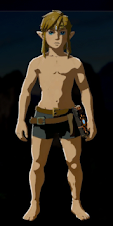Suppose that 21st century culture gravitates towards forms which best fit the attention span of the broadest demographic, and that this movement escalated mid 2016 onwards—taking place around the time The Legend of Zelda Breath of the Wild came out. Whereas games designed for greater mainstreaming tend to operate with broader strokes, Zelda’s narratives are intricate, giving the franchise illustrious value to those with an eye for it. Its sharp flavour comes from a weirdness unique to the common perspective; with this is a darkness and mysticism cutting with tangibility beyond any realm of the mundane; but most importantly, Zelda is home to a religiosity for aesthetic goodness, maintaining an encapsulated safe haven from modernities weaker recreational displays—For this sin it had to be subdued.
I was on vacation once and I met this fat British kid with a football shirt and a Switch. I asked him what games he had, he said: “FIFA and Zelda”. Prior to BOTW they would have been the last clique of person you’d expect to have any possible connection to the sort of culture Zelda came from—or at least used to (We had a cerebral and grimy culture too bad the weebs fucked all that shit up) It begs the question: why was this meathead playing a nerdy looking game based on peter pan? The thing is, anything you push on the masses will land eventually provided it meet a few bottom line standards. These were the standards Zelda had to metamorphasize to meet before becoming fit for broader mainstreaming. Changes had to be implemented, not just in terms of gameplay but primarily spirit.
BOTW is visually painful: everything is garish and shiny, which is weird because the game was spun as something to chill out to. Between the lines of searing colors and static visuals it gives off this deliriously floaty vibe like getting fatigued in hot weather.
Zelda is renowned for it’s weird atmospheric and to a potential, deeply emotional soundtracks. BOTW replaced it with generic Studio Ghibli piano music, the type Redditors like to call wholesome to feel better about themselves after masturbating to loli; it doesn’t matter that it lacks flavour or creativity; as long as its positive vibes it's viable to saturate the entire franchise’s mood. Whatever you think of the game's appearance it has to be understood that its developers sacrificed atmosphere for the quantity of a broader overworld.
The game’s dungeons are replaced with copy and paste trial rooms. Of the Zelda formula you perceive every area to be integrated within the game's narrative; It's hard to do so when every dungeon looks like something from Portal. Instead of an earthy mediaeval setting villages in BOTW consist of these utilitarian Playmobil pods looking like the sort of architecture which crops up in fluffy areas of the West.
Zelda has a history of interesting character design; it’s only recently that the franchise's aesthetic has too become enveloped as part of an encroaching design trend within Japanese media—designs so intricate that they stand unfit for a realistic environment, however at the same time too material to be considered ethereal or divine. Characters wear clothes which look like they'd fall off if you actually tried to walk around in them.
Zelda’s vibe is now another Genshin Fudgepact, something which the weeb already had a prolific selection of games to satisfy. The game's characters adhere to this tendency which modern media has to exaggerate attributes to one end or another. Compared to a lot of western media, Link's design is effeminate, however neutral within the game aesthetic he's home to; making him more like a youth warrior akin to Siegfried from the germanic mythos as opposed to another Duke Nukem.
This would have made more sense had the rest of the game's characters adopted the style, but all of the Gerudo still have these eerily realistic physiques. In effect Link doesn’t manifest the proportions of a cartoon, he just looks like a midget next to these Tumblr art style lesbians.
BOTW isn’t just a game, it’s a standard template for everything to come, as it’s identically ensuing sequel can attest too. This is how Mass subdued the soul of Zelda, something which had managed to avoid flattening for what’s hopefully the majority of its lifespan. It was a good run but they got it in the end. Whatever happens, the imprints of its abandoned spirit remain in preservation to be followed and taken from.































Link make my pp hard and its scary
ReplyDeleteScary boners ahhh
Delete